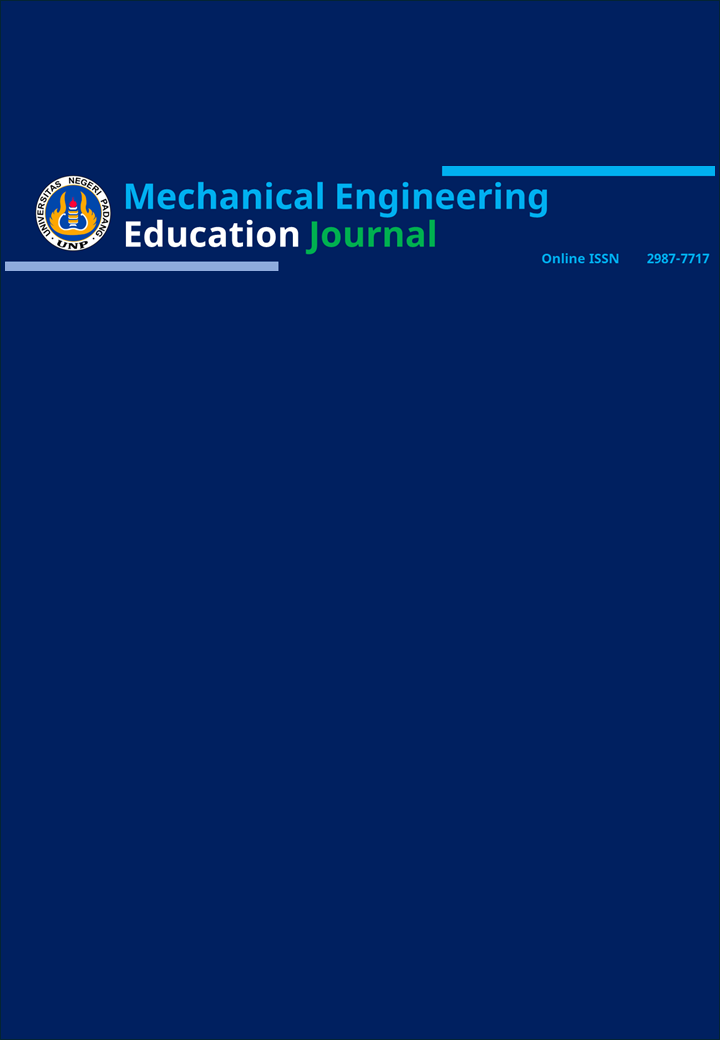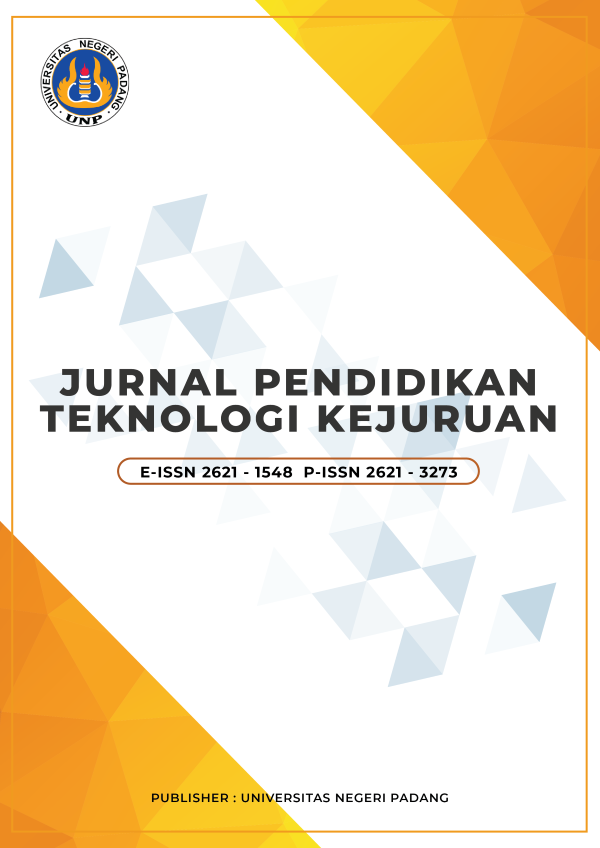Relationship of the student’s learning readiness and learning outcomes on technical drawing training
DOI:
https://doi.org/10.24036/meej.v1i2.30Keywords:
Learning Readiness, Learning Outcomes, Technical DrawingAbstract
This research aims to determine the correlation between learning readiness and learning outcomes of students in the Technical Drawing training course at SMK Negeri 1 Bukittinggi. The research method used is a quantitative descriptive method. Due to the population being less than 100 people, this research uses a population sample as the research sample, namely 34 students. Data collection techniques used were documentation, questionnaires and posttest questions. The results of this research show that learning readiness has an average (mean) distribution of scores of 86.50% (external indicators), 78.41% (internal indicators). Meanwhile, the learning outcomes with this score distribution obtained an average (mean) of 84.12%. Hypothesis testing on Learning Readiness (X) with Learning Outcomes (Y) of class So there is a positive and significant relationship between learning readiness and the learning outcomes of class X students majoring in Mechanical Engineering at SMK Negeri 1 Bukittinggi. The existence of a significant relationship is shown by r count = 0.978 > r table = 0.339. The relationship between learning readiness and learning outcomes is 97.8% or very high criteria. So this means that there is a significant relationship between learning readiness and student learning outcomes at SMK Negeri 1 Bukittinggi.
Downloads
References
Arikunto, S. (2006). Prosedur Penelitian: Suatu Pendekatan Praktik. Rineka Cipta.
Budiman, H., & Hamdani, A. (2017). Hubungan antara Kesiapan Belajar dengan Prestasi Belajar Siswa SMK. Journal of Mechanical Engineering Education, 4(1), 48. https://doi.org/10.17509/jmee.v4i1.7440
Effendi, E. (2017). Hubungan Readiness (Kesiapan) Belajar Siswa Dengan Hasil Belajar Fisika Siswa Kelas X Smk Muhammadiyah 03 Sukaraja. Jurnal Pendidikan Fisika, 5(1), 15. https://doi.org/10.24127/jpf.v5i1.740
Himmi, N., & Azni, A. (2017). Hubungan Kesiapan Belajar Dan Kecemasan Matematika Terhadap Hasil Belajar Matematika Siswa Smp. Pythagoras, 6(1), 22–30. https://doi.org/10.33373/PYTHAGORAS.V6I1.619
Khotimah, N., & Adi Heryadi, A. (2019). Metode Pembelajaran Koperatif Untuk Kesiapan Belajar Matematika Siswa Mts. Jurnal Psikologi Insight, 3(1), 10–19. https://doi.org/10.17509/insight.v3i1.22245
Pandiangan, W. M., Siagian, S., & Sitompul, H. (2018). Pengaruh Strategi Pembelajaran Dan Gaya Belajar Siswa Terhadap Hasil Belajar Matematika Siswa. Jurnal Teknologi Pendidikan (JTP), 11(1), 86. https://doi.org/10.24114/jtp.v11i1.11199
Rizki, U. Y. (2013). Hubunga Kesiapan Belajar Dengan Optimisme Mengerjakan. Educational Psychology Journal, 2(1), 49–56. http://journal.unnes.ac.id/sju/index.php/epj
Sappe, I., Ernawati, E., & Irmawanty, I. (2018). Hubungan Motivasi Belajar terhadap Hasil Belajar Ipa Siswa Kelas V sdn 231 Inpres Kapunrengan Kecamatan Mangarabombang Kabupaten takalar. JKPD (Jurnal Kajian Pendidikan Dasar), 3(2), 530. https://doi.org/10.26618/jkpd.v3i2.1419
Sari, E. K., & Ain, S. Q. (2022). Hubungan Kesiapan Belajar dengan Hasil Belajar Matematika Kelas IV SDN 013 Sukamaju Kecamatan Singingi Hilir. IJoIS: Indonesian Journal of Islamic Studies, 3(2), 149–162. https://doi.org/10.59525/ijois.v3i2.113
Sinta, V. (2017). Pengaruh Kesiapan Belajar Terhadap Hasil Belajar Mata Pelajaran Ekonomi Kelas X Di SMA Bina Jaya Palembang. Jurnal Ilmiah Pendidikan Dan Ekonomi, 1(1), 11–20. https://garuda.kemdikbud.go.id/documents/detail/1905628
Suwardi, D. R. (2012). Faktor-Faktor Yang Mempengaruhi Hasil Belajar Siswa Kompetensi Dasar Ayat Jurnal Penyesuaian Mata Pelajaran Akuntansi Kelas Xi Ips Di Sma Negeri 1 Bae Kudus. Economic Education Analysis Journal, 1(2).
Widodo, S. A., Prahmana, R. C. I., Purnami, A. S., & Turmudi. (2018). Teaching materials of algebraic equation. Journal of Physics: Conference Series, 943(1), 27–31. https://doi.org/10.1088/1742-6596/943/1/012017
Widyaningtyas, A., & Radiyono, Y. (2013). Peran Lingkungan Belajar Dan Kesiapan Belajar Terhadap Prestasi Belajar Fisika Siswa Kelas X Sekolah Menengah Atas Negeri 1 Pati. Jurnal Pendidikan Fisika, 1(1), 136.
Yandi, A., Nathania Kani Putri, A., & Syaza Kani Putri, Y. (2023). Faktor-Faktor Yang Mempengarui Hasil Belajar Peserta Didik (Literature Review). Jurnal Pendidikan Siber Nusantara, 1(1), 13–24. https://doi.org/10.38035/jpsn.v1i1.14
Downloads
Published
How to Cite
Issue
Section
License
Copyright (c) 2024 Fauzi Amad Arif, Kurniawan Andre, Primawati Primawati, Afnison Wanda

This work is licensed under a Creative Commons Attribution-ShareAlike 4.0 International License.
Most read articles by the same author(s)
- Indra Wita, Eko Indrawan, Irzal Irzal, Junil Adri, Primawati Primawati, Student's perceptions on choosing CAD software , Mechanical Engineering Education Journal: Vol. 1 No. 3 (2023): Regular Issue
- Zafira Nurramadhani, Remon Lapisa, Primawati Primawati, Sri Rizki Putri Primandari, Effectiveness of powerpoint learning media on students’ learning outcomes on basic mechanical engineering , Mechanical Engineering Education Journal: Vol. 1 No. 4 (2023): Regular Issue
- Diaz Ilyasa Nazri, Primawati Primawati, Rizky Ema Wulansari, Sri Rizki Putri Primandari, Improving students’ competence on software inventor by applying peer tutoring methods , Mechanical Engineering Education Journal: Vol. 1 No. 4 (2023): Regular Issue
- Verenza Delfira, Primawati Primawati, Rizky Ema Wulansari, Sri Rizki Putri Primandari, Implementation learning media based on fliphtml5 on students’ learning outcomes on basic welding , Mechanical Engineering Education Journal: Vol. 1 No. 4 (2023): Regular Issue




